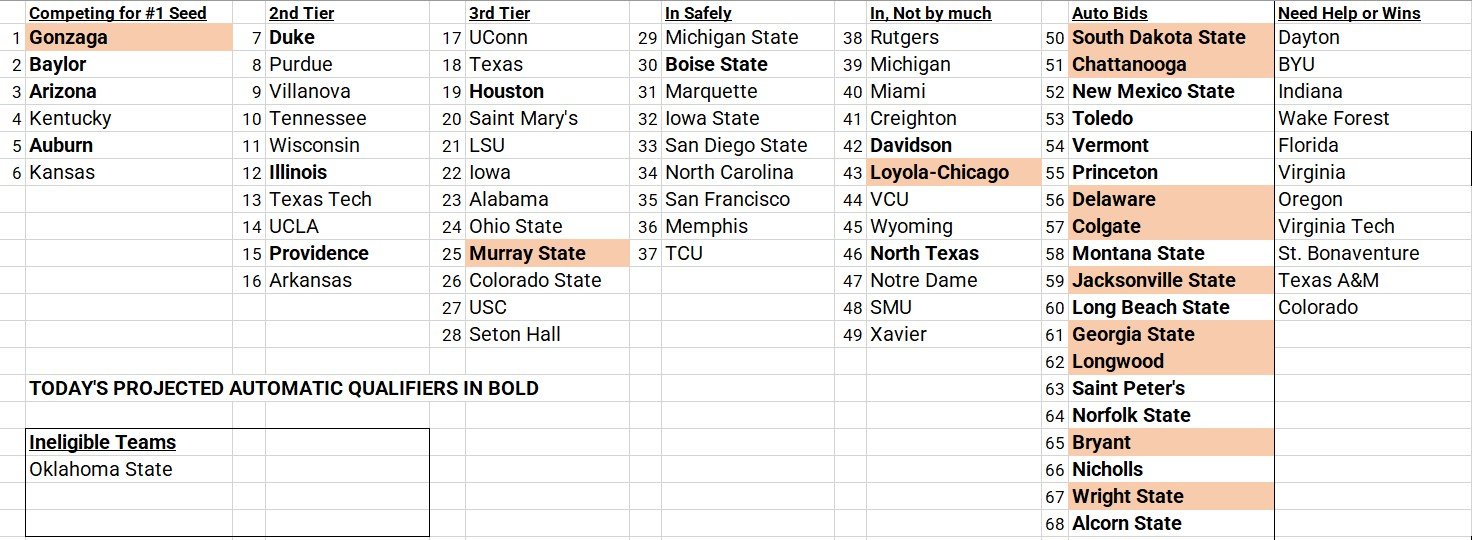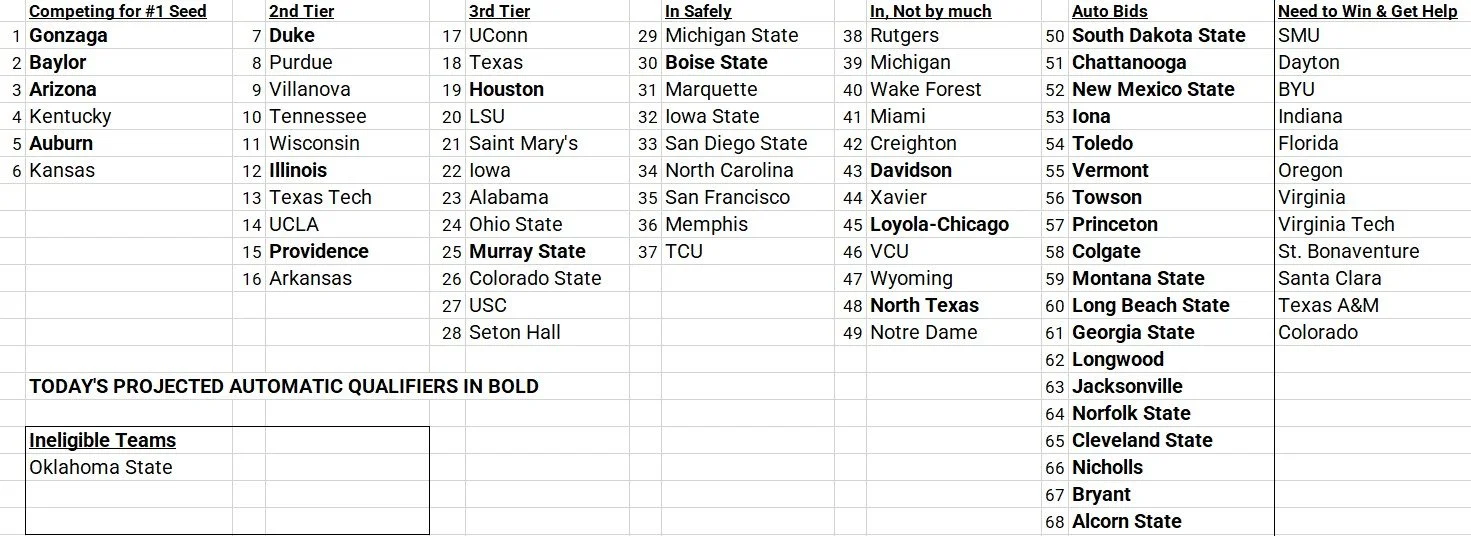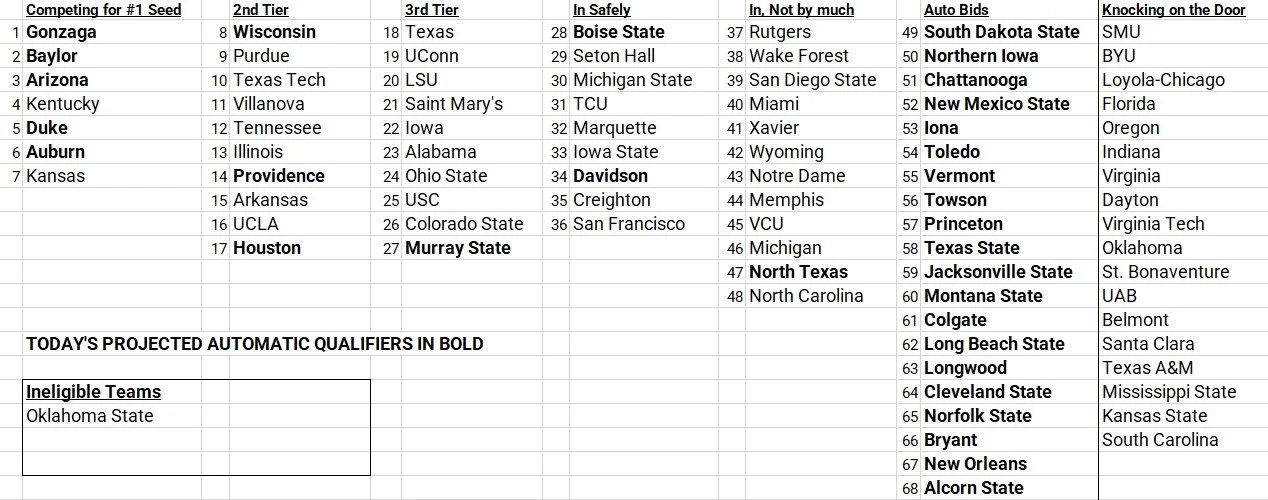What did we learn?
March of 2022 provided a combination of harsh reminders and stright surprises. A bevy of key results came through on Saturday, March 12th. Tennessee took down Kentucky in the SEC semifinals, Duke was punished by Virginia Tech in the ACC Tournament final, Purdue advanced to the B1G final with a win over Michigan State, bubble-team Texas A&M dismantled Arkansas by 18 in the other SEC semifinal, and bubble-team SMU lost a tight one to Memphis in an AAC semifinal.
All of this was factored into our final bracket on Selection Sunday. The move to put both Purdue and Tennessee became clear on the seeding list. Purdue snatching the final 2-seed here. The move to put Texas A&M in the field became quite clear, and SMU in our belief had enough on the resume to be more attractive than Notre Dame or Rutgers.
All of the above ended up working against the committee’s final opinion, and we paid a price in the bracket matrix due to this. As has been shared here before, the committee simply wrapped up their seeding process ahead of the aforementioned Saturday results. In effect, none of the results made a difference. One could argue that the Friday results had little impact. We know that each time a team takes the floor, it represents a small piece of the overall body of work. These games, in hindsight, had no weight.
Texas A&M and SMU missed the field. Duke remained a two-seed. Virginia Tech stayed stuck as an 11-seed despite the great wins of Championship Week. The list goes on. All of this personally does bother me, yes. However, the purpose of the work here is to be as accurate as possible. It is something that has come up before in a previous bracket, and this served as a harsh reminder. Kudos to the handful of people who actually accounted for no results in their final bracket projection. The willpower and foresight were easier said than done. We have no choice but to apply these learnings to the upcoming selection process of 2023.
Forecasted Bid Breakdown - 2023
The Power-6 plus AAC, A10, MWC, and WCC make up the multi-bids for 2023. From time to time, we will showcase the Missouri Valley here as well, and I went ahead and left the MVC projected order of finish for us to track, despite being forecasted initially as just a one-bid league.
After months of discussions, reading, listening, and tracking personnel changes, I’ve put my best guesses for this season together. I have considered the early, middle, and late-season scenarios based on coaching philosophy, roster makeup, and overall perceived team strength. You will notice that some leagues have a different league champion than the projected Auto-Bid winner. This was done by design, as it is realistic to see this play out annually.
B1G
The Big Ten model for scheduling combined with the sheer competitiveness of the league continues to benefit its members. Despite a lack of a prominent powerhouse, there is a lot of solid across the Big Ten, and getting to a non-conference .750 winning pct. league-wide should not be an issue. That figure of .750 tends to bring many key measurement metrics up and is the goal of several leagues. The Big Ten has been doing it for a while now. Last season both Rutgers and Indiana (seen celebrating in 2022 below) squeezed into the First Four in Dayton. Rare to see two of the four spots given to the same league. Rutgers is once again left out of the project 2023 field, and we will likely regret this. Penn State is the dark horse to pay attention to from the B1G.
LINK - Indiana’s 2022 celebration on Selection Sunday en route to Dayton.
ACC & SEC
The SEC enters with seven forecasted tournament bids. Confidence within the SEC is stronger than the ACC behind established powers in Kentucky and Tennessee. Arkansas, Alabama, and Auburn have had a ton of recent success, here come more loaded rosters. We love what Texas A&M brings back this year, and Florida is very deep with two stars in Colin Castleton and Kyle Lofton. Watch out for Mississippi State and LSU, who have new staff and a load of talent - but not quite projected in.
In the ACC, the footing is less solid. Yes, pencil in UNC and Duke - no doubt. Virginia appears to be ready to get back to the top. Florida State is healthy, long, and athletic again. Miami has made a ton of off-season noise following an Elite Eight appearance and gets the nod for now. Stever Forbes’ Wake Forest group may have a slight talent drop-off, yet this staff can flat-out coach and we love the adjustments Wake made to its scheduling philosophy. It’s enough to warrant a First Four projection. Virginia Tech also came in with an at-large worthy evaluation here. The biggest issue? Schedule strength could end up being a thorn for the Hokies, which is enough cause for concern to make them the first team out.
Steve Forbes on scheduling this season:






















